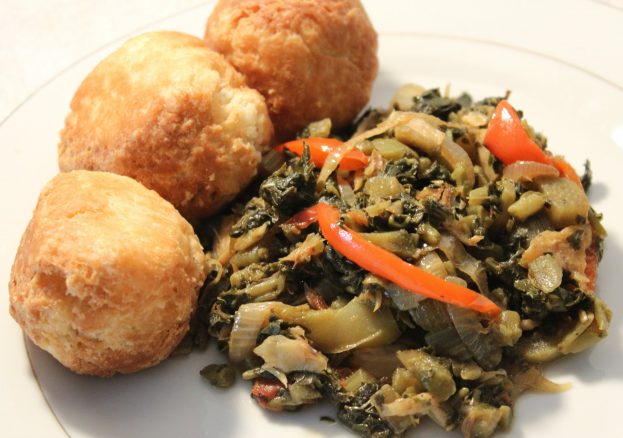The Caribbean is usually mentioned because the actual ‘melting pot within the Americas,’ where people, their culture, customs, and cuisines, were forcibly integrated with the newer imports of African people under European bondage. Today, we trace back the origins of 1 of those ‘melting pot’ creations; Callaloo with Dumplings and Saltfish.
The actual origins of Callaloo are widely contested. For Trinidadians, Callaloo is one a part of their national dish: Crab and Callaloo- a meal which was created by the African slaves sometime around 1530 when the island was under Spanish occupation.
It means while the dish could also be a national staple on both islands in Trinidad and Tobago, the origins of the dish stem long after the arrival of African slaves circa-1510. Furthermore, documents detailing the cuisine of Africans by English and Dutch Explorers within the 1400s, depict Callaloo as a daily ingredient in dishes, most noticeably ones which include spinach.
However, the difference in preparation between African Callaloo found within the Caribbean and particularly in Trinidad and Tobago is the use of vegetable oil. As a readily available plant throughout West Africa, vegetable oil was and still is employed during a sort of dish throughout Nigeria, Congo, Sierra Leone, and Angola. However, within the Caribbean, where Palm trees and alas, vegetable oil isn’t native or wildly available, the slaves within the 1530s were forced to improvise using what was readily available near or on their plantations- coconut.
As the processes between copra oil and vegetable oil are vastly different, the resulting crude not only changes the depth of flavors between the two differing types of Callaloo but their flavor profiles and health properties also, with vegetable oil having more carcinogenic properties than its copra oil variant, even as having a more ‘slimy’ texture and slightly more bitter taste.
Regardless of the flavor of food, the Slaves merely sought out the oil for its ability to stay the Callaloos’ texture firm and consistent throughout the dish, preventing it from becoming almost paste-like inconsistency.
Yet surprisingly, the tactic of how the slaves extracted the oil from the coconut is comparatively unchanged over the past 400 years, with the slaves initially grating a dry coconut into a pulp before squeezing the liquid out through a sieve, leading to a product that had the color of milk which they might then add into the ingredients to form Callaloo.
Now while Callaloo was a tasty and sometimes filling morsel for the ill-treated slaves to dine on, the time-consuming nature of making Callaloo from scratch was often too risky for it to be a daily sort of sustenance. As such, an alternate was forcibly needed; dumplings.
While both Caribbean and African cuisines now use a mixture of plain and self-rising flour made up of wheat for his or her dumplings today, the Slaves wouldn’t have had access to wheat crops. Instead, Cassava, which was cultivated by several plantations for its similarities to wheat and potatoes, would make the first adaptations of dumplings within the West Indies.
In both cases, where the ingenuity of the enslaved lay was what they accompanied their carbohydrate-heavy dishes with; seafood. As crabs were often the foremost easy to catch of all the seafood available thanks to Trinidad and Tobago’s abundance of shorelines, Crabs rock-pooling along the shore were easy targets for slaves trying to find a fast bite.
As restrictions on the movement of slaves both on and off the plantation grew and therefore the penalties for escaping or maybe wondering out of the estate became more severe, the utilization of crabs fizzled out by the mid-1500s. Instead, the enslaved were forced to seem for an alternative to their dish- which they found in Saltfish.
Initially used as a fertilizer for the crops, ‘Salt-fish’- which was merely any white fish that was doused in salt, was often useable fish that slave owners didn’t want to use to feed their slaves/. Initially, the fertilizer was cannon fodder, but after slaves ate the fish while working the fields, Plantation owners added salt to discourage their slaves from eating the produce. As such, initial adopters of raw SaltfishSaltfish were those that were hungry, a choice which frequently became a cause for his or her death thanks to dehydration. Those that were caught eating the Saltfish were reprimanded with lashes, muzzles, and within the case of known repeat offenders, the removal of their tongue.
It meant that for the Saltfish to become a useable or maybe integral a part of a meal, it had to be processed- which was often done by ‘washing’ the salt of the fish where available, boiling the fish till the salt came off as a silted layer within the water, or soaking the fish till the taste of the salt was almost completely removed.
Today, Callaloo with Dumplings and Saltfish maybe a hearty, filling meal eaten by Trinidadians, often on a Sunday when available. In recent years, and with the growing acknowledgment of Trinidad’s Asian influence, Roti is included or maybe wont to substitute for the Dumplings. At the same time, Crabs are re-introduced into the dish to accompany and even contrast the more savory flavor of the Salted fish.
most credit goes to blackhistorymonth.org.uk

